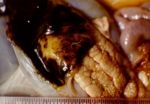Trichuris
| Trichuris spp. | |
|---|---|
| Kingdom | Animalia |
| Phylum | Nematoda |
| Class | Enopla |
| Sub-class | Dorylaimia |
| Order | Trichocephalida |
| Super-family | Trichinelloidea |
| Family | Trichuridae |
| Genus | Trichuris |
| Species | T. vulpis, T. suis, T. campanula |
Also known as: Whipworm
Overview
The Trichuris worms, part of the Trichinelloidea superfamily, are so called due to their characteristic whip like structure. They have a broad posterior end tapering to a long and narrow neck which is inserted into the caecal mucosa. They have a direct life cycle, moving directly into the definitive host from the infective L1 egg stage. Once ingested the larva is freed from the egg casing due to digestion of the plugs at either end of the egg. The larvae then form mucosal nodules in which to develop before emerging into the lumen of the large intestine and caecum of the host.
Characteristics
Eggs
The eggs of Trichuris species are yellow/brown in colour and are bioperculated (have a plug in each end). They are hardy eggs and in the correct conditions can survive on pasture for up to 12 years. The Trichuris embryo develops inside the egg and is infective as the 1st larval stage living within the egg.
Larvae
Hatch from the egg into the small intestine and there grow and moult until the reach adulthood.
Adult
Attach to the mucosa of the large intestine.
Life Cycle
The life cycle is not a standard nematode life cycle as these species are infective within the egg at a very early stage of embryo development. This means infective eggs can be present on pasture within 10 - 14 days of adult patency. Eggs are transferred to pasture in the feaces of the host animal and then ingested by animals grazing on the pasture; feaco-oral spread. Thrichuris spp. have no tissue migratory period, living their entire lives in the small and large intestine of the host.
Important Species
There are several species of veterinary importance, each typically infecting a different host species;
- Trichuris vulpis; the dog whipworm
- Trichuris campanula (Europe) and Trichuris serrata (North America); cat whipworms, though these are only seen rarely.
- Trichuris suis; the pig whipworm
Pathogenesis
Adult worms bury the thin anterior into the intestinal mucosa and feeds on tissue secretions from the damaged cells rather than blood. The invasion of the worm causes eosinophilia in the host animal as it mounts an immune response against the worm. The most common clinical signs are:
- Diarrhoea
- Catarrhal enteritis
- Anaemia
- Dehydration
| Trichuris Learning Resources | |
|---|---|
To reach the Vetstream content, please select |
Canis, Felis, Lapis or Equis |
 Search for recent publications via CAB Abstract (CABI log in required) |
Trichuris publications since 2000 |
| This article has been peer reviewed but is awaiting expert review. If you would like to help with this, please see more information about expert reviewing. |
Error in widget FBRecommend: unable to write file /var/www/wikivet.net/extensions/Widgets/compiled_templates/wrt6961e3fadc33b5_54504181 Error in widget google+: unable to write file /var/www/wikivet.net/extensions/Widgets/compiled_templates/wrt6961e3fae47095_44780035 Error in widget TwitterTweet: unable to write file /var/www/wikivet.net/extensions/Widgets/compiled_templates/wrt6961e3fae8f957_89596857
|
| WikiVet® Introduction - Help WikiVet - Report a Problem |


